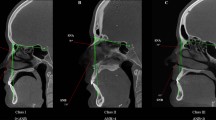Abstract
Objectives
The soft palate in normal individuals exhibits morphological variety on cephalometry. The purpose of the present study was to explore its causes and investigate its possible effects in clinical practice.
Methods
Cephalometric and cone-beam computed tomography (CBCT) data for 30 subjects were collected. The morphology of the soft palate on cephalometry was classified into two main types, eyebrow shape and spoon shape. Comparisons between these two types on both cephalometric and CBCT images were made.
Results
Comparing these two types, there was a significant difference in the distance between the tip of the uvula and the palatopharyngeus (p < 0.01) as well as in the angle between the uvula and the palatopharyngeus (p < 0.01). The velar length on CBCT imaging was longer than that on cephalometry for the spoon-shape group (p < 0.01) and the overall subjects (p < 0.01).
Conclusions
Based on the present results, we speculate that overlapping of the palatopharyngeus and the uvula, which is mainly determined by their relative positions, contributes to the contour of the soft palate on cephalometry. This overlapping phenomenon partly explains the morphological variety of the soft palate on cephalometry, and should be considered during measurement and evaluation of the soft palate.








Similar content being viewed by others
References
Kollias I, Krogstad O. Adult craniocervical and pharyngeal changes—a longitudinal cephalometric study between 22 and 42 years of age. Part II: morphology of uvulo-glossopharyngeal changes. Eur J Orthod. 1999;21:345–55.
You M, Li X, Wang H. Morphological variety of the soft palate in normal individuals: a digital cephalometric study. Dentomaxillofac Radiol. 2008;37:344–9.
Kosowski TR, Weathers WM, Wolfswinkel EM, Ridgway EB. Cleft palate. Semin Plast Surg. 2012;26:164–9.
Nanci A. Ten Cate’s oral histology: development, structure, and function. 2nd ed. St. Louis: Mosby; 2008. p. 365–6.
Richard D, Wayne V, Adam M. Gray’s anatomy for students. 2nd ed. Beijing: Medical Publishers of Peking University; 2010. p. 867–9.
Alsufyani NA, Noga ML, Finlay WH, Major PW. Topical contrast agents to improve soft-tissue contrast in the upper airway using cone beam CT: a pilot study. Dentomaxillofac Radiol. 2013;42:20130022.
Sutthiprapaporn P, Tanimoto K, Ohtsuka M, Nagasaki T, Konishi M, Iida Y, et al. Improved inspection of the lateral pharyngeal recess using cone-beam computed tomography in the upright position. Oral Radiol. 2008;24:71–5.
Yamashina A, Tanimoto K, Ohtsuka M, Nagasaki T, Sutthiprapaporn P, Iida Y, et al. A morphological comparison of the piriform sinuses in head-on and head-rotated views of seated subjects using cone-beam computed tomography. Oral Radiol. 2008;24:64–70.
Ingman T, Nieminen T, Hurmerinta K. Cephalometric comparison of pharyngeal changes in subjects with upper airway resistance syndrome or obstructive sleep apnoea in upright and supine positions. Eur J Orthod. 2004;26:321–6.
Camacho M, Capasso R, Schendel S. Airway changes in obstructive sleep apnoea patients associated with a supine versus an upright position examined using cone beam computed tomography. J Laryngol Otol. 2014;128:824–30.
Pepin JL, Veale D, Ferretti GR, Mayer P, Levy PA. Obstructive sleep apnea syndrome: hooked appearance of the soft palate in awake patients—cephalometric and CT findings. Radiology. 1999;210:163–70.
Mortimore IL, Douglas NJ. Palatopharyngeus has respiratory activity and responds to negative pressure in sleep apnoeics. Eur Respir J. 1996;9:773–8.
Mazaheri M, Athanasiou AE, Long RE. Comparison of velopharyngeal growth patterns between cleft lip and/or palate patients requiring or not requiring pharyngeal flap surgery. Cleft Palate Craniofac J. 1994;31:452–60.
Satoh K, Wada T, Tachimura T, Shiba R. The effect of growth of nasopharyngeal structures in velopharyngeal closure in patients with repaired cleft palate and controls without clefts: a cephalometric study. Br J Oral Maxillofac Surg. 2002;40:105–9.
Park S, Omori M, Kato K, Nitta N, Kitano I, Masuda T. Cephalometric analysis in submucous cleft palate: comparison of cephalometric data obtained from submucous cleft palate patients with velopharyngeal competence and incompetence. Cleft Palate Craniofac J. 2002;39:105–9.
Satoh K, Wada T, Tachimura T, Fukuda J. Velar ascent and morphological factors affecting velopharyngeal function in patients with cleft palate and noncleft controls: a cephalometric study. Int J Oral Maxillofac Surg. 2005;34:122–6.
Witt PD, Marsh JL, Marty-Grames L, Muntz HR, Gay WD. Management of the hypodynamic velopharynx. Cleft Palate Craniofac J. 1995;32:179–87.
Satoh K, Wada T, Tachimura T, Sakoda S, Shiba R. A cephalometric study of the relationship between the level of velopharyngeal closure and the palatal plane in patients with repaired cleft palate and controls without clefts. Br J Oral Maxillofac Surg. 1999;37:486–9.
Conflict of interest
Feng Bin, You Meng, Jiang Meng, and Wang Hu declare that they have no conflict of interest.
Human rights statement
All procedures followed were in accordance with the ethical standards of the responsible committee on human experimentation (institutional and national) and with the Helsinki Declaration of 1964 and later versions.
Informed consent
Informed consent was obtained from all patients for being included in the study.
Author information
Authors and Affiliations
Corresponding author
Rights and permissions
About this article
Cite this article
Bin, F., Meng, Y., Meng, J. et al. Comparison of velum morphologies using cephalometry and dental CBCT. Oral Radiol 32, 1–8 (2016). https://doi.org/10.1007/s11282-015-0200-1
Received:
Accepted:
Published:
Issue Date:
DOI: https://doi.org/10.1007/s11282-015-0200-1




